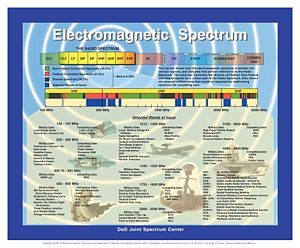Electromagnetic spectrum
The Electromagnetic Spectrum is the name given to the range of electromagnetic waves covering all frequencies and wavelengths. It includes radio and television transmission, Microwaves, Infrared, visible light, Ultraviolet, X-rays, and Gamma rays. The relatively new (since the 1990s) technology of terahertz (THz) radiation can be thought of as occupying a gap between infrared radiation and microwaves, covering frequencies of roughly 0.1 to 10 THz.
Electromagnetic radiation
All electromagnetic radiation can be described in terms of its Energy (E), frequency (f), wavenumber (v'), or wavelength (). These properties are all related by the following equations:
- ,
- ,
where c = 299,792,458 m/s (the speed of light) and h = 6.626 x 10-34 Js (Planck's constant)
As well as the wavelike properties of EM radiation several effects particularly of the emission and absorption of light behave like particles. That is, the energy carried by light waves is packaged in discrete bundles called photons or quanta. The particle character of light is described in quantum electrodynamics, a theory which began with Dirac's work of 1927.[1]
- See also: electromagnetic wave
Electromagnetic spectrum as a resource
Especially in radio and radar frequencies, the electromagnetic spectrum can be a scarce and valuable resource, since a given frequency in a given geographic area can often be used only for one purpose. This is a classic requisite of a technical monopoly. If a frequency is in use for commercial television, than it cannot be used for cellular telephony. In electronic warfare, there may be difficult tradeoffs between letting an enemy use a radio frequency for his own purposes while one's own side is gaining signals intelligence from it, or jamming to deny its use for command and control.
See electromagnetic spectrum management for the policy, management, and commercialization of parts of the spectrum.
Reference
- ↑ P.A.M. Dirac, Proc. Royal Society (London), The Quantum Theory of the Emission and Absorption of Radiation, vol. A114, p. 243 (1927)
Further reading
- Young and Freedman. University Physics. Addison-Wesley Publishing Company. ISBN 0-201-31132-1
- NASA introduction to electromagnetic spectrum



